27 Jul Free to Be You: My Interview with David Baker
David Baker lights up any...

David Baker lights up any...
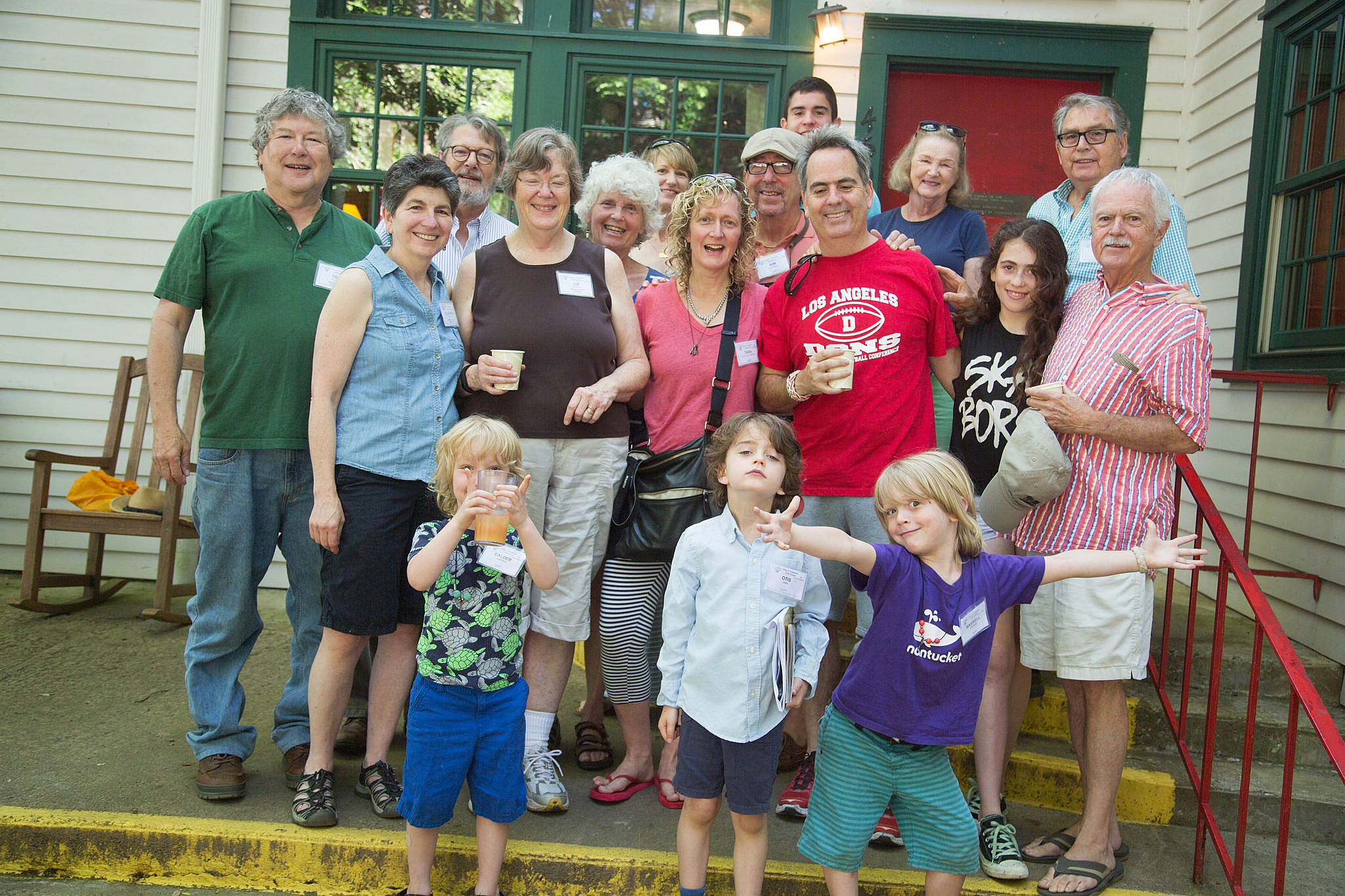 The Olive Dame family gather for a quick photo in front of Keith House. Kids, standing left to right: Calder LaFollette Huck, Otis Cary, Maxwell LaFollette Huck. Second row, left to right Toby Sackton (married to Marcia), Elisabeth Sackton (married to Liz Coolidge), Liz Coolidge, Tavia LaFollette, Donick Cary, Amadi Cary, Richard Cary. Back row, left to right: Jan Davidson, Marcia Butman, Kim Huffman Cary, Kim Huffman, Josh Wipf (behind Kim), Jeanne Huffman, Lorin Cary.[/caption]
Members of Folk School founder Olive Dame Campbell's family gathered here during a recent weekend in June (12-14) for a mini-family reunion and a chance to experience the Folk School. While some members took classes in Photography, Spinning, and Gardening, others spent time on campus, browsing the school’s archives, visiting and meeting with Folk School staff and community members. I recently caught up with Marcia Butman (Olive was Marcia's Great Aunt) and Tavia LaFollette Zabriske (Olive was her Great Great Aunt) to ask them about their thoughts about the Folk School and to learn more about their family’s connection to Olive.
KG: Tell us why you decided to gather your family here for a mini-reunion at the Folk School.
MB: I had been reading Olive’s diary and sending it out on a daily basis to a large group of extended family, calling it “Dame A Day.” I sent out the year of Olive’s baby Jane’s life, from April 1912 through January 1913. I think this really involved our family in Olive’s life, and we began talking about holding a reunion at the school. Toby and I visited the school twice in the past ten years and I also visited with my daughter for the day when we were at The Great Smokies. We also hosted Jan and Nanette in Nantucket when they came to do a talk and concert. Our relationship to them made me feel it would be possible to arrange a family visit. Jan and Nanette are such special and wonderful welcoming people, they were very positive and enthusiastic about the idea of a reunion and I knew they would help us arrange a reunion. And they did so much to make the weekend great.
However, it seemed very difficult to come up with a date. Then Lorin Cary, whose brother, Richard lives in Asheville, said he was planning to visit on Richard June 12, after his grandson’s graduation from High School in Toledo, and both of them were going to go visit the school. Once one person said they were definitely coming, it all fell into place. (Olive was also Great Aunt to both Lorin and Richard. They are the sons of Olive's niece June and Harry Cary, who lived and worked at the Folk School from 1938-41).
TLZ: I have grown up with stories and artifacts. This was an opportunity to learn and share with family, first hand, in a place that has captured and treasures cultural heritage. What a unique opportunity!
The Olive Dame family gather for a quick photo in front of Keith House. Kids, standing left to right: Calder LaFollette Huck, Otis Cary, Maxwell LaFollette Huck. Second row, left to right Toby Sackton (married to Marcia), Elisabeth Sackton (married to Liz Coolidge), Liz Coolidge, Tavia LaFollette, Donick Cary, Amadi Cary, Richard Cary. Back row, left to right: Jan Davidson, Marcia Butman, Kim Huffman Cary, Kim Huffman, Josh Wipf (behind Kim), Jeanne Huffman, Lorin Cary.[/caption]
Members of Folk School founder Olive Dame Campbell's family gathered here during a recent weekend in June (12-14) for a mini-family reunion and a chance to experience the Folk School. While some members took classes in Photography, Spinning, and Gardening, others spent time on campus, browsing the school’s archives, visiting and meeting with Folk School staff and community members. I recently caught up with Marcia Butman (Olive was Marcia's Great Aunt) and Tavia LaFollette Zabriske (Olive was her Great Great Aunt) to ask them about their thoughts about the Folk School and to learn more about their family’s connection to Olive.
KG: Tell us why you decided to gather your family here for a mini-reunion at the Folk School.
MB: I had been reading Olive’s diary and sending it out on a daily basis to a large group of extended family, calling it “Dame A Day.” I sent out the year of Olive’s baby Jane’s life, from April 1912 through January 1913. I think this really involved our family in Olive’s life, and we began talking about holding a reunion at the school. Toby and I visited the school twice in the past ten years and I also visited with my daughter for the day when we were at The Great Smokies. We also hosted Jan and Nanette in Nantucket when they came to do a talk and concert. Our relationship to them made me feel it would be possible to arrange a family visit. Jan and Nanette are such special and wonderful welcoming people, they were very positive and enthusiastic about the idea of a reunion and I knew they would help us arrange a reunion. And they did so much to make the weekend great.
However, it seemed very difficult to come up with a date. Then Lorin Cary, whose brother, Richard lives in Asheville, said he was planning to visit on Richard June 12, after his grandson’s graduation from High School in Toledo, and both of them were going to go visit the school. Once one person said they were definitely coming, it all fell into place. (Olive was also Great Aunt to both Lorin and Richard. They are the sons of Olive's niece June and Harry Cary, who lived and worked at the Folk School from 1938-41).
TLZ: I have grown up with stories and artifacts. This was an opportunity to learn and share with family, first hand, in a place that has captured and treasures cultural heritage. What a unique opportunity!
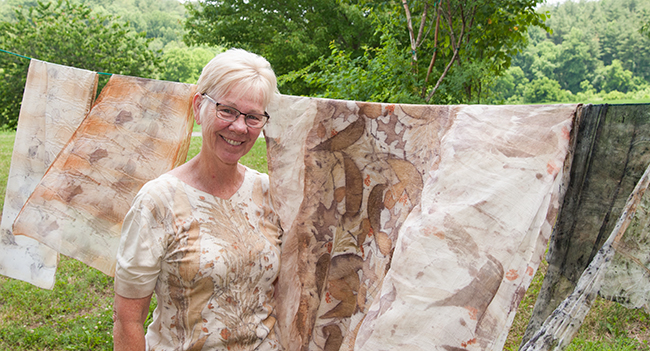 Kathy Hays displays her eco print creations outside the Wet Room.[/caption]
[caption id="attachment_13334" align="alignright" width="234"]
Kathy Hays displays her eco print creations outside the Wet Room.[/caption]
[caption id="attachment_13334" align="alignright" width="234"]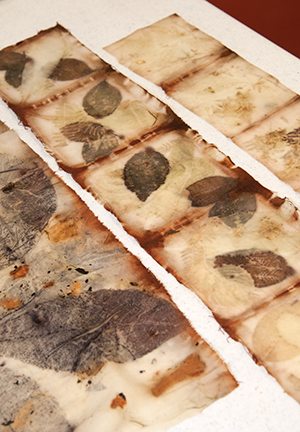 Class projects[/caption]
I stopped by the Wet Room to visit Kathy Hays' recent class "Eco Printing Meets Felt Making" to see what they were creating. I talked to Kathy about her craft and the joys of eco printing. Enjoy our interview!
CP: Tell me about where you're from, what you do there, and about your craft.
KH: I’m from Florida, an unusual area for felt making due to the climate. I began making felt here at the Folk School in 1999. After struggling and trying to figure how to make felt on my own, I was able to come here and after the first day, it was like all my questions were answered! The rest of the week was purely a bonus.
CP: How is Nuno Felting different from other felting?
KH: Felt making is wool fibers being arranged and then adding soap, water, and agitation. In the case of Nuno Felting, you are merging fibers through another fabric. The term is a little ambiguous. That fabric can be cotton, linen... anything that is thin enough for it to come through. It creates a unique texture when it does that.
Class projects[/caption]
I stopped by the Wet Room to visit Kathy Hays' recent class "Eco Printing Meets Felt Making" to see what they were creating. I talked to Kathy about her craft and the joys of eco printing. Enjoy our interview!
CP: Tell me about where you're from, what you do there, and about your craft.
KH: I’m from Florida, an unusual area for felt making due to the climate. I began making felt here at the Folk School in 1999. After struggling and trying to figure how to make felt on my own, I was able to come here and after the first day, it was like all my questions were answered! The rest of the week was purely a bonus.
CP: How is Nuno Felting different from other felting?
KH: Felt making is wool fibers being arranged and then adding soap, water, and agitation. In the case of Nuno Felting, you are merging fibers through another fabric. The term is a little ambiguous. That fabric can be cotton, linen... anything that is thin enough for it to come through. It creates a unique texture when it does that.
A big congratulations to Brasstown...
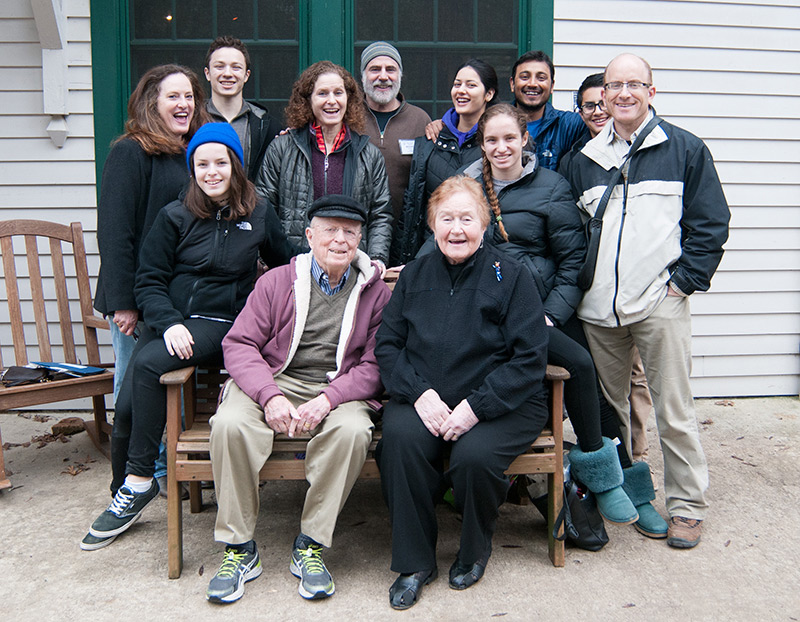 (Front Row) Dr. Fred & Mrs. Martha U. Goldner (Second Row L. to R.) Hannah Niederman, Francie Niederman, Natalie Niederman, Fredjoseph Goldner, (Third Row L. to R.) Cynthia Goldner, Aaron Niederman, Michael Niederman, Sana Singh, Prash Singh, and Julian Goldner.[/caption]
[caption id="attachment_12848" align="alignright" width="244"]
(Front Row) Dr. Fred & Mrs. Martha U. Goldner (Second Row L. to R.) Hannah Niederman, Francie Niederman, Natalie Niederman, Fredjoseph Goldner, (Third Row L. to R.) Cynthia Goldner, Aaron Niederman, Michael Niederman, Sana Singh, Prash Singh, and Julian Goldner.[/caption]
[caption id="attachment_12848" align="alignright" width="244"]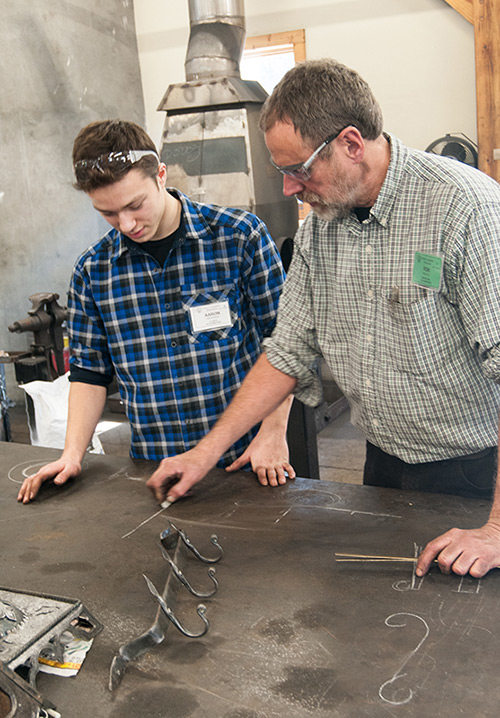 Aaron Niederman plans his Blacksmithing project with instructor Ron Nichols.[/caption]
While Fred & Martha toasted their 60th, one of their two daughters, Francie Niederman, of Skokie, IL, also celebrated her 20th anniversary with her husband Michael. Three generations of family members and their friends came to the Folk School to take a variety of Weekend classes including: Blacksmithing, Jewelry, Enameling, Drawing, Woodturning, and Woodworking. Creativity seems to run in the family. Their daughter, Cynthia, promotes her innovative art at Makin Time Clocks and their grandson, Julian, was a Silver Medalist in the most recent Scholastic Art Awards Competition.
Seeing them in the studio, at our family-style meals in the Dining Hall, and at Show and Tell was delightful. They made it look like the most incredible family vacation ever. I talked with Martha about her Folk School experience and what it was like to have her family congregate in Brasstown for this very special occasion:
CP: Congratulations once again on your anniversary! Was this your first trip to the Folk School?
MG: Fred and I had a previous experience at JCCFS around the same time of year in 2011. We took Bistro Cooking and Fiber Arts & Knitting.
[caption id="attachment_12840" align="alignleft" width="286"]
Aaron Niederman plans his Blacksmithing project with instructor Ron Nichols.[/caption]
While Fred & Martha toasted their 60th, one of their two daughters, Francie Niederman, of Skokie, IL, also celebrated her 20th anniversary with her husband Michael. Three generations of family members and their friends came to the Folk School to take a variety of Weekend classes including: Blacksmithing, Jewelry, Enameling, Drawing, Woodturning, and Woodworking. Creativity seems to run in the family. Their daughter, Cynthia, promotes her innovative art at Makin Time Clocks and their grandson, Julian, was a Silver Medalist in the most recent Scholastic Art Awards Competition.
Seeing them in the studio, at our family-style meals in the Dining Hall, and at Show and Tell was delightful. They made it look like the most incredible family vacation ever. I talked with Martha about her Folk School experience and what it was like to have her family congregate in Brasstown for this very special occasion:
CP: Congratulations once again on your anniversary! Was this your first trip to the Folk School?
MG: Fred and I had a previous experience at JCCFS around the same time of year in 2011. We took Bistro Cooking and Fiber Arts & Knitting.
[caption id="attachment_12840" align="alignleft" width="286"]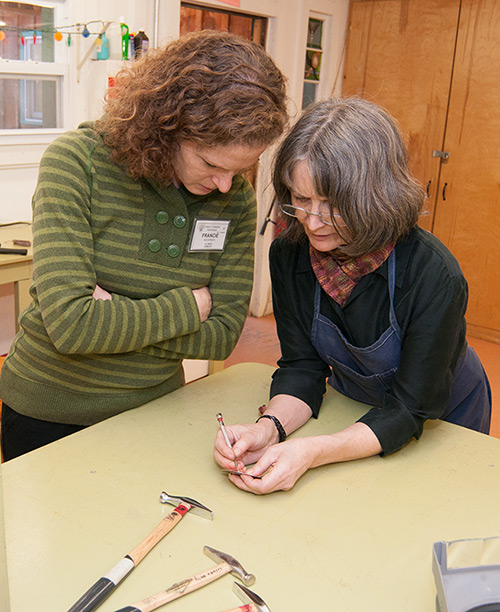 Francie learns a jewelry technique from Kay Patterson.[/caption]
CP: What made you decide to pick the Folk School as a destination for your anniversary celebration?
MG: We identified our anniversary celebration with family. A weekend of the exact dates was in the catalogue and it was a perfect place away from everyone's usual environment. A place of unknown demands on them, yet programmed for each one to be surprised and inspired.
CP: How many of your family members congregated at the Folk School? Who came from the furthest destination?
MG: Of the twelve members there were three couples. Our son came from San Jose, Costa Rica.
CP: How did you decide what classes to take?
MG: When the idea was hatched we distributed the outline and description of what was available so they quickly made choices before the classes filled up.
Francie learns a jewelry technique from Kay Patterson.[/caption]
CP: What made you decide to pick the Folk School as a destination for your anniversary celebration?
MG: We identified our anniversary celebration with family. A weekend of the exact dates was in the catalogue and it was a perfect place away from everyone's usual environment. A place of unknown demands on them, yet programmed for each one to be surprised and inspired.
CP: How many of your family members congregated at the Folk School? Who came from the furthest destination?
MG: Of the twelve members there were three couples. Our son came from San Jose, Costa Rica.
CP: How did you decide what classes to take?
MG: When the idea was hatched we distributed the outline and description of what was available so they quickly made choices before the classes filled up.
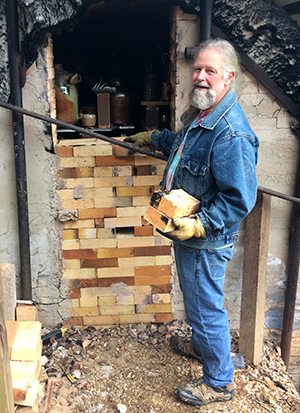 Rob unbricks the kiln.[/caption]
It's like Christmas Eve over at Smoke in the Mountains Pottery today because it's the day before the big wood kiln will be opened and unloaded. Many potters from all over the region contribute pots to be fired the traditional way in Rob Withrow's huge wood kiln. This is Rob's 13th wood firing at his studio. I stopped by and caught him taking a little peek inside the chamber and took the opportunity to talk to him about the firing and clay in general. Join us in the sneak peek...
CP: So what are you doing right now?
RW: I'm unbricking this kiln here that's been cooling for five days. We heated it up to 2500 degrees using only wood, and now it's like Christmas! You open it up and see what's inside and this time the kiln fired so beautifully; it's such a joy.
CP: Nice, How many time have you fired this kiln?
RW: It's been a hard road but I stuck with it, and by golly the community came forth and helped me all along the way. I fired it nine times unsuccessfully. A weaker man would have caved or a smarter man would have stopped, but I kept going and here we are! The community came together and knew I was having problems. We put a new chimney on it and it works like a charm now. Now it's a third of the wood, and a third of the time (than when we first started).
[caption id="attachment_12738" align="aligncenter" width="565"]
Rob unbricks the kiln.[/caption]
It's like Christmas Eve over at Smoke in the Mountains Pottery today because it's the day before the big wood kiln will be opened and unloaded. Many potters from all over the region contribute pots to be fired the traditional way in Rob Withrow's huge wood kiln. This is Rob's 13th wood firing at his studio. I stopped by and caught him taking a little peek inside the chamber and took the opportunity to talk to him about the firing and clay in general. Join us in the sneak peek...
CP: So what are you doing right now?
RW: I'm unbricking this kiln here that's been cooling for five days. We heated it up to 2500 degrees using only wood, and now it's like Christmas! You open it up and see what's inside and this time the kiln fired so beautifully; it's such a joy.
CP: Nice, How many time have you fired this kiln?
RW: It's been a hard road but I stuck with it, and by golly the community came forth and helped me all along the way. I fired it nine times unsuccessfully. A weaker man would have caved or a smarter man would have stopped, but I kept going and here we are! The community came together and knew I was having problems. We put a new chimney on it and it works like a charm now. Now it's a third of the wood, and a third of the time (than when we first started).
[caption id="attachment_12738" align="aligncenter" width="565"]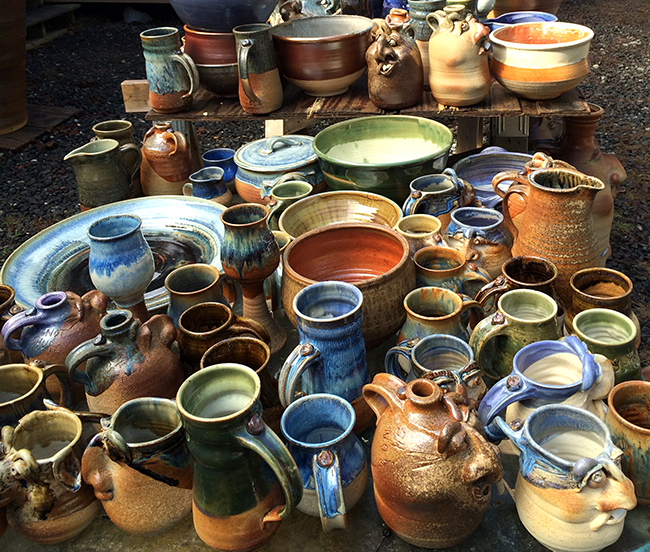 Beautiful pots from the March 2015 wood firing[/caption]
Beautiful pots from the March 2015 wood firing[/caption]
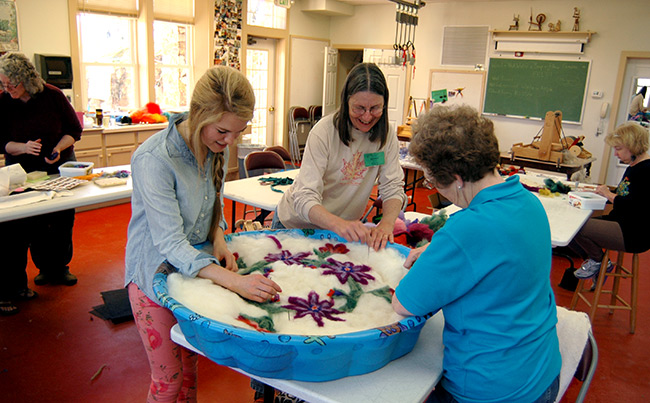 Felted Rug Class with Becky Walker in the Wet Room[/caption]
Felt is the oldest known fabric used by man. That stands to figure... felt is so easy to make, it was probably first discovered by accident. The recipe for felt, after all, is wool, moisture and agitation. Picture lining a sandal or shoe with raw wool to act as a cushion. Now picture walking around on that wool, smooshing it with every step, maybe sweating on it a bit to add the needed moisture. By the end of a long walk, you're not taking out bits of raw wool, but essentially a felted sock that fits your feet perfectly. While felting techniques have come a long way, that essential concept of felt making is still the same.
I sat down to talk with Becky Walker about her adventures with felt making. You've seen Becky around the Folk School campus wearing a knit hat, sweater or socks, or maybe on the dance floor wearing her felted name tag. Wherever you may meet Becky, her enthusiasm for her passions – music, dance, good food, good friends, animals and fiber – becomes clear right away. Let's meet her.
[caption id="attachment_12657" align="alignright" width="208"]
Felted Rug Class with Becky Walker in the Wet Room[/caption]
Felt is the oldest known fabric used by man. That stands to figure... felt is so easy to make, it was probably first discovered by accident. The recipe for felt, after all, is wool, moisture and agitation. Picture lining a sandal or shoe with raw wool to act as a cushion. Now picture walking around on that wool, smooshing it with every step, maybe sweating on it a bit to add the needed moisture. By the end of a long walk, you're not taking out bits of raw wool, but essentially a felted sock that fits your feet perfectly. While felting techniques have come a long way, that essential concept of felt making is still the same.
I sat down to talk with Becky Walker about her adventures with felt making. You've seen Becky around the Folk School campus wearing a knit hat, sweater or socks, or maybe on the dance floor wearing her felted name tag. Wherever you may meet Becky, her enthusiasm for her passions – music, dance, good food, good friends, animals and fiber – becomes clear right away. Let's meet her.
[caption id="attachment_12657" align="alignright" width="208"]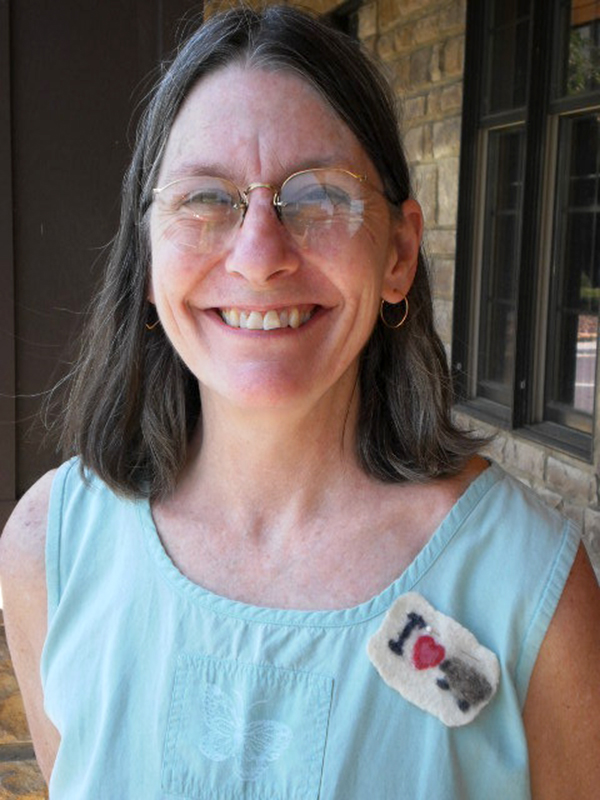 Becky and her felted name badge[/caption]
CC: How did you first become interested in becoming a fiber artist?
BW: Well, my mother taught me to knit when I was a real little kid, I was about seven. I've always loved animals, or anything with fur, anyway, and one thing lead to another. I've pretty much continued knitting through out my life so far. So I haven't knitted all my life yet (she laughs).
CC: How did you discover the Folk School?
BW: After I met Steve, my husband. He was a Folk School person and this was one of the first places we came. His son, Able lived over here, and he wanted me to meet Able and his mom. Of course we had to come dance because we were right here. Actually, I had encountered the Folk School in my early 20s in the book Handicrafts of the Southern Highlands. There was a chapter on the Folk School and I thought, “Wow, that seems like such a great place. I'd love to go there!” but didn't really think I ever would. So the fact that we came here right away was pretty neat, and I've been loving it ever since. It was a while before I got to take a class, so anyway, we'd come here to dance and see family.
CC: What kind of fiber arts do you do?
[caption id="attachment_12666" align="alignright" width="217"]
Becky and her felted name badge[/caption]
CC: How did you first become interested in becoming a fiber artist?
BW: Well, my mother taught me to knit when I was a real little kid, I was about seven. I've always loved animals, or anything with fur, anyway, and one thing lead to another. I've pretty much continued knitting through out my life so far. So I haven't knitted all my life yet (she laughs).
CC: How did you discover the Folk School?
BW: After I met Steve, my husband. He was a Folk School person and this was one of the first places we came. His son, Able lived over here, and he wanted me to meet Able and his mom. Of course we had to come dance because we were right here. Actually, I had encountered the Folk School in my early 20s in the book Handicrafts of the Southern Highlands. There was a chapter on the Folk School and I thought, “Wow, that seems like such a great place. I'd love to go there!” but didn't really think I ever would. So the fact that we came here right away was pretty neat, and I've been loving it ever since. It was a while before I got to take a class, so anyway, we'd come here to dance and see family.
CC: What kind of fiber arts do you do?
[caption id="attachment_12666" align="alignright" width="217"]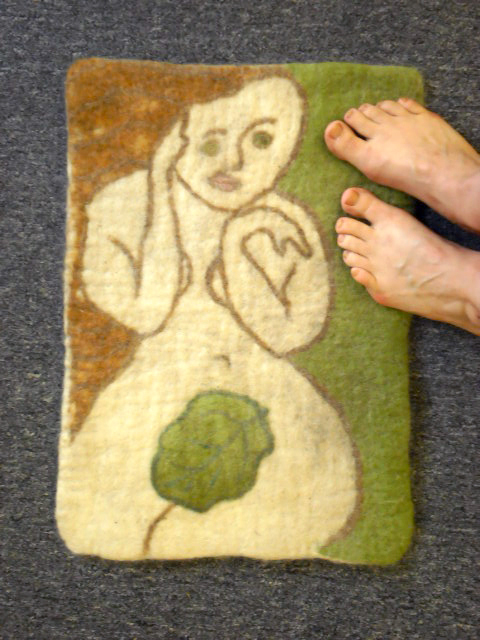 Felted Rug with Woman[/caption]
BW: Well, felt making is what I've become known for and I dabble a little bit with spinning. I'm not very good, but I just need to sit down at my wheel and do it more.
CC: Martha Owen, the Folk School Resident Artist in Knitting and Spinning, told me a story about teaching you to spin and you told her you might be more interested in felt making, right?
BW: I told her that I loved her, that I was interested in spinning, but I wasn't really ready to sit still yet. And so when I said that, she said “Well, you know, there's this thing called felt making and it's really active and I think you would like it. Carla is teaching a class here at the Folk School sometime coming up pretty soon and I think you should try that.” So I did.
Felted Rug with Woman[/caption]
BW: Well, felt making is what I've become known for and I dabble a little bit with spinning. I'm not very good, but I just need to sit down at my wheel and do it more.
CC: Martha Owen, the Folk School Resident Artist in Knitting and Spinning, told me a story about teaching you to spin and you told her you might be more interested in felt making, right?
BW: I told her that I loved her, that I was interested in spinning, but I wasn't really ready to sit still yet. And so when I said that, she said “Well, you know, there's this thing called felt making and it's really active and I think you would like it. Carla is teaching a class here at the Folk School sometime coming up pretty soon and I think you should try that.” So I did.
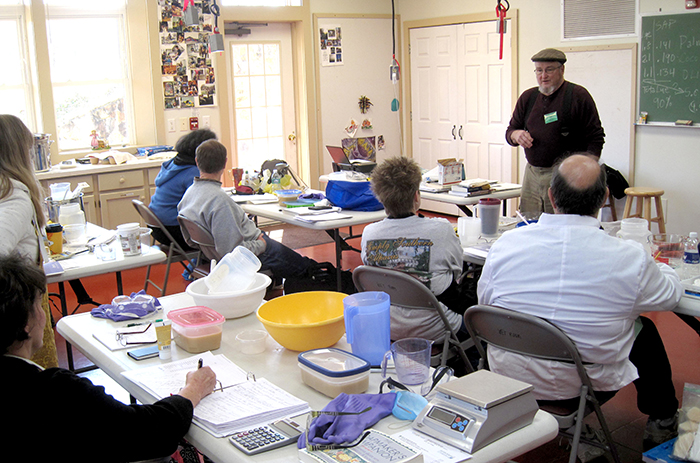 Tim Tyndall teaches Soap Making in the Wet Room[/caption]
Tim Tyndall teaches Soap Making in the Wet Room[/caption]
When I was a Work/Study in 2011, one of the classes I chose for my work/trade was Dr. T’s Soap Making class. For a total beginner, the class was an amazing introduction to the chemistry and art behind creating your own customized cold process soap batches. Dr. T (aka Tim Tyndall) teaches Soap Making regularly at the Folk School. I'm a huge fan of Tim and his soap... Enjoy our interview.
[caption id="attachment_12629" align="alignright" width="216"]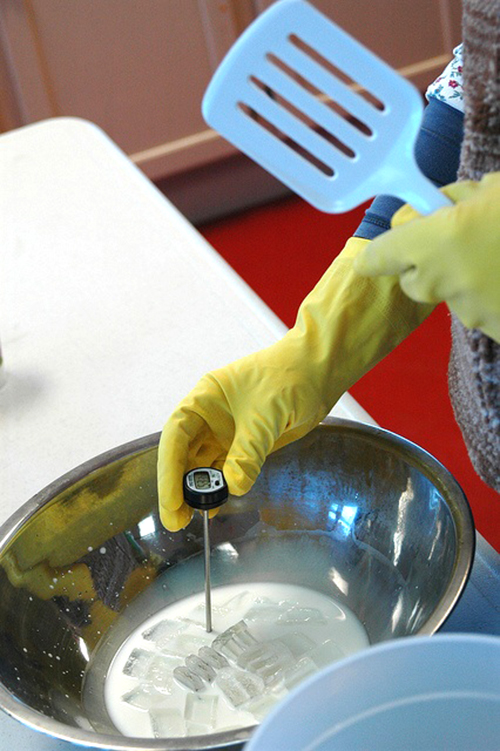 Checking the temperature of the milk and lye.[/caption]
Checking the temperature of the milk and lye.[/caption]
CP: How did you become involved with the Folk School?
Dr. T: About 10-12 years ago, Charlotte Latin School bused their 8th grade “graduates to be” to the Folk School for a celebration where students could choose 2-4 classes over a 2-day period. A parent who had been a customer and attended one of my demonstrations here at the Soap Shed, suggested to someone at the Folk School that they contact me to do Soap Making segments for the Latin students.
The Folk School contacted me and I came down to initiate a soap class experiment. Things went well; the students were pleased; I had fun; and I was asked to propose what regular soap classes might look like for the curriculum. Soap Making classes have been a part of the “curriculum” since then. I guess I have kinda been the “lead dog,” so to speak.
CP: Why do you like teaching at the Folk School?
First and foremost, I have always loved teaching. I have been an educator and administrator at all levels from private high school, community college, and university, focusing in science. I live in Spruce Pine, NC where we have the Penland School of Crafts and taught in Rome, Georgia, home of the Berry School. These schools, like JCCFS and Berea, focus on the goal of helping mountain or rural people marshall their skills and talents from generations of practice towards economic gain and enrichment for themselves, their families, and their communities.
I expected this would be the “Spirit of the Folk School” which I so richly enjoyed my first visit. To be a part of that AND to share some of my self taught skills as a contemporary soap maker is a most satisfying endeavor. I have learned much “Lore” and have a cadre of stories about the history of soap making as a foundation craft in an earlier time and an artisan craft today. I teach because it is FUN and I love seeing my students accomplish things they came to the school thinking they could not do or understand. They surprise themselves and give a thrill at the same time. That’s why I like teaching at the Folk School.
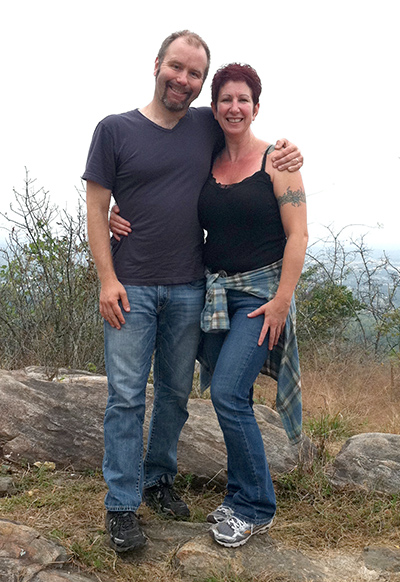 Ivan & Leanne[/caption]
I met Ivan Ewert in Leatherworking class at the Folk School this past fall. While we were busy cutting and riveting leather in the Wood Carving Studio, Ivan's wife Leanne was just across the way in the Jewelry Studio shaping metal into wearable treasures. This was Leanne and Ivan's second trip to the Folk School together. They were celebrating their 15th anniversary. It was inspirational to see in action how the Folk School is an awesome destination for couples. With V-Day right around the corner, I decided now was a great time to catch up with them about their Folk School experience. Enjoy!
CP: How did you hear about the Folk School?
IE: Leanne is a jewelry artist who subscribes to many art magazines. There was an advert in the back of one of them that grabbed her interest, and when we looked the school up online we knew it was something we had to do together.
LE: I had been looking at that advertisement for sometime and when I finally mentioned it to Ivan, he was just as excited about the adventure as I was!
CP: Why did you decide it would be a fun place to come as a couple?
IE: We rarely vacation apart, so if one was going, the other was too! Leanne's interest in learning new skills to apply to her career was inspiring. There was a painting class taking place at the same time as the classes she wanted to take, and a week painting in the mountains sounded like a wonderful retreat.
[caption id="attachment_12505" align="aligncenter" width="480"]
Ivan & Leanne[/caption]
I met Ivan Ewert in Leatherworking class at the Folk School this past fall. While we were busy cutting and riveting leather in the Wood Carving Studio, Ivan's wife Leanne was just across the way in the Jewelry Studio shaping metal into wearable treasures. This was Leanne and Ivan's second trip to the Folk School together. They were celebrating their 15th anniversary. It was inspirational to see in action how the Folk School is an awesome destination for couples. With V-Day right around the corner, I decided now was a great time to catch up with them about their Folk School experience. Enjoy!
CP: How did you hear about the Folk School?
IE: Leanne is a jewelry artist who subscribes to many art magazines. There was an advert in the back of one of them that grabbed her interest, and when we looked the school up online we knew it was something we had to do together.
LE: I had been looking at that advertisement for sometime and when I finally mentioned it to Ivan, he was just as excited about the adventure as I was!
CP: Why did you decide it would be a fun place to come as a couple?
IE: We rarely vacation apart, so if one was going, the other was too! Leanne's interest in learning new skills to apply to her career was inspiring. There was a painting class taking place at the same time as the classes she wanted to take, and a week painting in the mountains sounded like a wonderful retreat.
[caption id="attachment_12505" align="aligncenter" width="480"]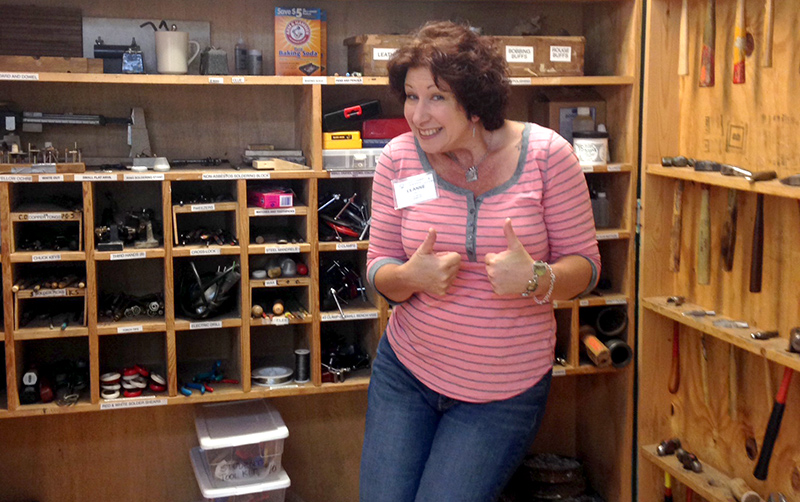 Leanne's "Mecca"- the vast supply closet in the Folk School Jewelry Studio.[/caption]
LE: I work out of my home studio and it can become a very solitary/insular life if one is not careful. The opportunity to be surrounded by, and learn from, other creatives that work in my chosen field sounded fabulous and I immediately wanted to go. I was born and raised in the south, so any chance I have to go back home is always a big treat for me. This is the best of both worlds AND I get to share it with the person I love. This last trip was our anniversary gift to one another!
CP: How many times have you come to the Folk School? What classes have you taken?
IE: Only twice so far, and never a class together. Leanne's focused on jewelry but branched into leatherwork with Donna Wiggins this year. I've taken painting, leatherwork, and The Art of Smoke... all of my classes have been a real treat.
LE: The first time we came down, I took a week-long wire wrapping class with Judy Peppers. This last time, I was getting more advanced instructions in Metalsmithing with Tom And Kay Benham for my week course and then onto a much-too short weekend session with Donna Wiggins for beginner work in leather...LOVED IT!!!
Leanne's "Mecca"- the vast supply closet in the Folk School Jewelry Studio.[/caption]
LE: I work out of my home studio and it can become a very solitary/insular life if one is not careful. The opportunity to be surrounded by, and learn from, other creatives that work in my chosen field sounded fabulous and I immediately wanted to go. I was born and raised in the south, so any chance I have to go back home is always a big treat for me. This is the best of both worlds AND I get to share it with the person I love. This last trip was our anniversary gift to one another!
CP: How many times have you come to the Folk School? What classes have you taken?
IE: Only twice so far, and never a class together. Leanne's focused on jewelry but branched into leatherwork with Donna Wiggins this year. I've taken painting, leatherwork, and The Art of Smoke... all of my classes have been a real treat.
LE: The first time we came down, I took a week-long wire wrapping class with Judy Peppers. This last time, I was getting more advanced instructions in Metalsmithing with Tom And Kay Benham for my week course and then onto a much-too short weekend session with Donna Wiggins for beginner work in leather...LOVED IT!!!
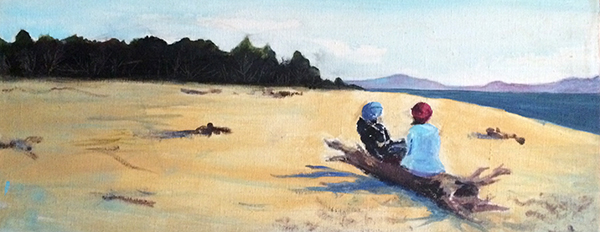 Painting by Sara Boggs[/caption]
Every time I see Sara Boggs around campus, like a giddy child, I ask her: "Can I see your sketchbook?" She always says "yes." You see, Sara is one of those artists who constantly carries her handmade sketchbook around, capturing tiny moments of life here and there - taking the time to practice and develop her drawing ability everyday. It has been incredible to see her book grow with the faces, places, and the spirit of the Folk School during her host term this fall. She permitted me to scan in some pages from her book to share with you. We also sat down over cookies and tea to talk about her experience as host and artistic journaler.
[caption id="attachment_12174" align="alignright" width="229"]
Painting by Sara Boggs[/caption]
Every time I see Sara Boggs around campus, like a giddy child, I ask her: "Can I see your sketchbook?" She always says "yes." You see, Sara is one of those artists who constantly carries her handmade sketchbook around, capturing tiny moments of life here and there - taking the time to practice and develop her drawing ability everyday. It has been incredible to see her book grow with the faces, places, and the spirit of the Folk School during her host term this fall. She permitted me to scan in some pages from her book to share with you. We also sat down over cookies and tea to talk about her experience as host and artistic journaler.
[caption id="attachment_12174" align="alignright" width="229"]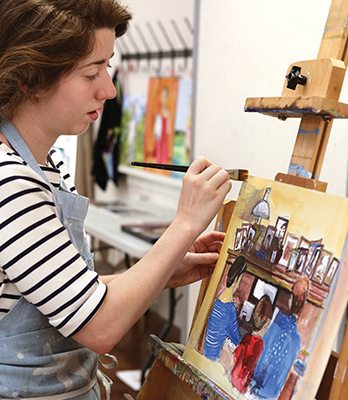 Sara in the Folk School Painting Studio[/caption]
CP: You were recently a character in the night of Holiday Revelry hosted by David Vowell. Who did you play?
SB: I got to play a couple of different characters: an all around reveler drinking wassail, the Little Pickle Boy in one of the tales about St. Nicholas, and Jack the Green in the mummer’s play. Jack’s character is traditionally full of mischief! In our play, Jack the Green saves the day in the story of St. George and the Dragon.
CP: Very nice. So you are wrapping up your host term at the Folk School? What's been your favorite part of being host?
SB: It’s the people… it’s for sure the people. Every week, I get to meet all of these wonderful people with amazing stories and wonderful things that they have done. They are all so sweet and encouraging – they make me feel like this world we have here that’s not quite real life – this fairy tale world that’s all fiddle music and blacksmith coal – is something that we can carry always. It’s been really wonderful to meet them all.
CP: Do you have any specific memories that resonate with you?
SB: There have been quite a few. Maybe it was because it was so early on in my time here, but one that sticks out is a magical cooking class dinner party. The class was a wood fired cooking class and they had their Thursday night dinner outside on picnic tables, with candle light torches. There was wine, and ukelele music, and a beautiful pink sunset overhead… little dogs came wandering through. It was slow and delicious. I wasn’t even supposed to be there, I was just crashing, but they let me crash. It was a lovely evening and I felt like it was the right way to start off my foot here.
[caption id="attachment_12175" align="aligncenter" width="600"]
Sara in the Folk School Painting Studio[/caption]
CP: You were recently a character in the night of Holiday Revelry hosted by David Vowell. Who did you play?
SB: I got to play a couple of different characters: an all around reveler drinking wassail, the Little Pickle Boy in one of the tales about St. Nicholas, and Jack the Green in the mummer’s play. Jack’s character is traditionally full of mischief! In our play, Jack the Green saves the day in the story of St. George and the Dragon.
CP: Very nice. So you are wrapping up your host term at the Folk School? What's been your favorite part of being host?
SB: It’s the people… it’s for sure the people. Every week, I get to meet all of these wonderful people with amazing stories and wonderful things that they have done. They are all so sweet and encouraging – they make me feel like this world we have here that’s not quite real life – this fairy tale world that’s all fiddle music and blacksmith coal – is something that we can carry always. It’s been really wonderful to meet them all.
CP: Do you have any specific memories that resonate with you?
SB: There have been quite a few. Maybe it was because it was so early on in my time here, but one that sticks out is a magical cooking class dinner party. The class was a wood fired cooking class and they had their Thursday night dinner outside on picnic tables, with candle light torches. There was wine, and ukelele music, and a beautiful pink sunset overhead… little dogs came wandering through. It was slow and delicious. I wasn’t even supposed to be there, I was just crashing, but they let me crash. It was a lovely evening and I felt like it was the right way to start off my foot here.
[caption id="attachment_12175" align="aligncenter" width="600"]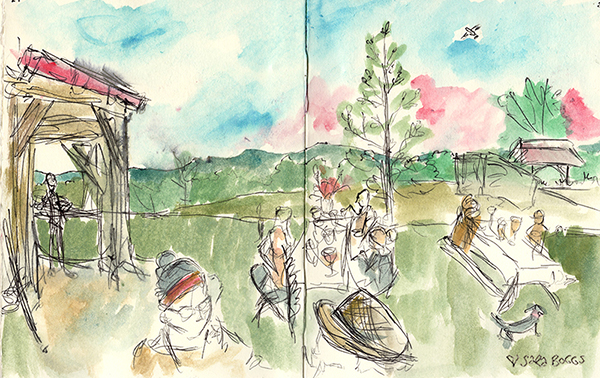 Page from Sara's sketchbook: Thursday night dinner party for the Cooking Class[/caption]
Page from Sara's sketchbook: Thursday night dinner party for the Cooking Class[/caption]


